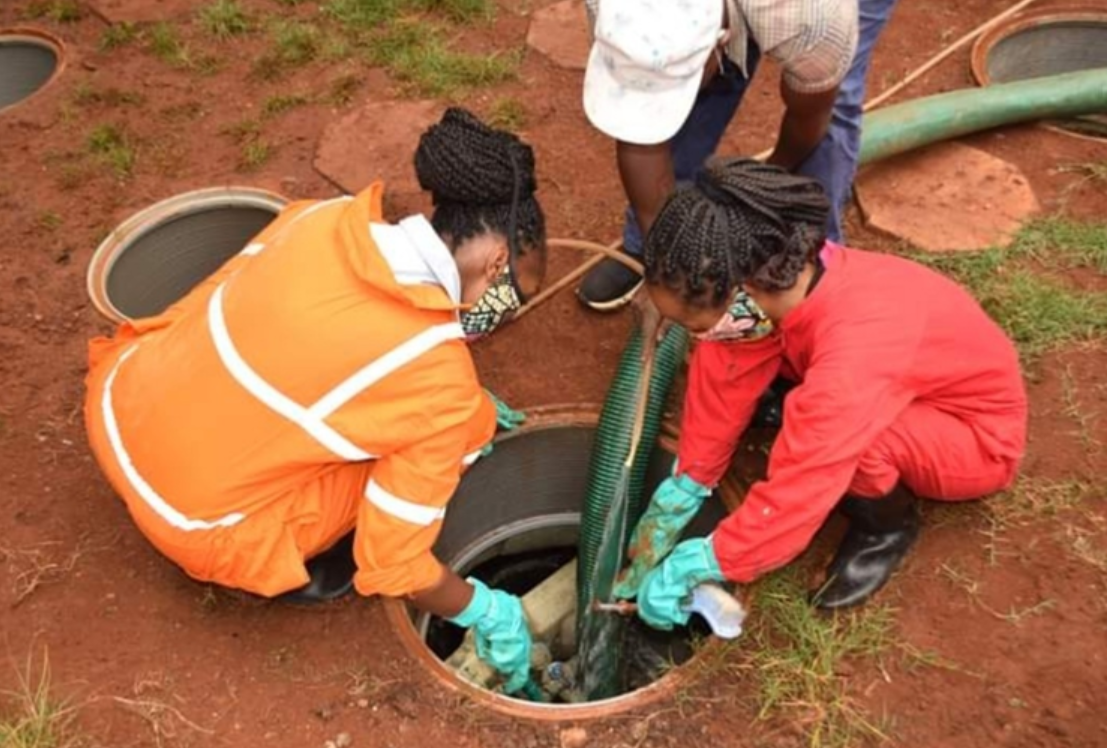"In Diversity there is beauty and there is strength" - Maya Angelou
Published on: 02/02/2023

Female wastewater operators servicing a client's Johkasou wastewater treatment plant, Kenya, 2022. Credit: Euphresia Luseka
Diversity is the difference. People are the same and different by their ethnic, age, professional experience, religion, race, and gender.
Let’s agree that women’s contributions and leadership are central to providing solutions to water challenges. Consequently, the water sector needs a more diverse labour force to establish a more inclusive and equitable experience for all its practitioners. By highlighting the scale of issues facing female Water leaders, we can better understand their challenges, and galvanize action for progressive, systemic change while examining other robust potential and scalable solutions.
The current women’s underrepresentation in water sector leadership is a prominent concern. According to a World Bank publication on Women in Water Utilities, women are significantly underrepresented; less than 18% of the workforce sampled were women, one in three utilities sampled had no female engineers and 12% of utilities have no female managers. Referencing the analysis of the employment data from participating organisations in a FLUSH LLC publication that I co-authored, white males from High-Income Countries comprised over a third of all sanitation leadership positions. With regards to race, two-thirds of all sanitation leaders were white, with white leaders 8.7 times more likely to hold multiple positions across different organisations than Black, Indigenous and People of Colour (BIPOC). BIPOC Women were the least represented group.
This affirms the importance of an intersectional perspective in advancing gender and racial equity in the water sector leadership.
Women and specifically BIPOC female water leaders are missing out on opportunities in the water sector that hold the promise of advancement of SDG6 targets and the rising economic security that comes with it.
Without diverse leadership, the water sector will continue to experience failure.
Gender diversity in the Water sector is not only a pressing political, moral and social issue but also a critical economic challenge. There are consequences for not having women in water leadership, the financial consequences are significant.
The untapped and unmeasured contribution of women is enormous. Women make up half the world’s population but generate 37% of the global GDP, reflecting the fact that they have unequal access to labour markets, opportunities, and rights. A McKinsey & Co study found that companies in the top quartile for gender or racial and ethnic diversity are more likely to have financial returns above their national industry medians. Companies in the bottom quartile in these dimensions are statistically less likely to achieve above-average returns.
The business case for diversity also remains strong. Research shows when women are well represented at the top, organisations are 50% more likely to outperform their peers. Undoubtedly, organisations in the Water sector that embraced diversification in terms of gender and race are positioned to meaningfully outperform their more homogeneous counterparts.
Beyond that, compared to senior-level men, senior-level women have a vast and meaningful impact on an organisation’s culture; they champion racial and gender diversity more.
Unfortunately, given the high male dominance in the Water sector they are usually the “Onlys” – the only or one of the only women hence more resistance, sharper criticism especially on affirming their competence, more prejudice, and more experience to micro-aggressions.
Absolutely, diversity wins and here are some examples of what I mean.
Though many ambitious women in water desire to advance into leadership positions, very few have the managerial and Ally support to get and keep those positions. Though many employees perceive themselves as our Allies, they do not take enough action such as publicly advocating for racial or gender equality, publicly confronting discrimination, publicly mentoring and sponsoring them. Though women in water have the capacity to lead in the sector, there exist geographic mismatches between them and opportunities, we remain underrepresented and paid less. Though many organisations are hiring more women to entry-level positions numbers dwindle at management level, particularly for BIPOC women.
This obviously has a long-term impact on the talent pipeline; eventually, there are fewer women to hire, fewer to promote to senior managers and overall fewer women in the sector. If women continue encountering the sticky floor, a broken rung on the ladder to success, and a revolving door in entry-level jobs, we might never break the glass ceiling.
Women can never catch up with this status quo!
We have come from so far as a sector but have moved very little on Gender parity at the workplace.
To give an illustration, the United Nations organised four outstanding world conferences for women: 1) at Mexico City in 1975; establishing the World Plan of Action and Declaration of Equality of Women and their Contribution to Development and Peace. 2) The Copenhagen conference in 1980. 3) the Nairobi Conference in my country Kenya, in 1985. 4) in Beijing in 1995 which marked a significant turning point for the global agenda on gender equality with an outcome of a global policy document.
27 years later, still the water sector is investing in the same gender challenges emerging from gender norms that are stuck with us generation after generation.
On the current trajectory, the World Economic Forum reckons if progress towards gender parity proceeds at the same pace, the global gender gap will close in 132 years. The Index concludes that “no country has reached the ‘last mile’ on gender equality” on more complex issues like gender-based violence, gender pay gaps, equal representation in powerful positions, gender budgeting and public services and climate change.
Women’s dual roles and time burden affect their economic productivity however inequalities in access to education impact their growth attributing to the high rates of poor women. Therefore, the woman in water at work and society starts at a disadvantaged position.
This affirms the supposition that instead of making transformation the goal in gender and water sector leadership, how about we make it a way of doing business?
As demonstrated in Eagly (2007) study, women are manifesting leadership styles associated with effective performance. On the other hand, there appears to be widespread recognition that women often come in second to men in leadership competitions. Women are still suffering disadvantage in access to leadership positions as well as prejudice and resistance when they occupy these roles. It is more difficult for women than men to become leaders and to succeed in male-dominated leadership roles. This mix of apparent advantage and disadvantage that women leaders experience reflects the considerable progress towards gender equality that has occurred in both attitudes and behaviour, coupled with lack of complete attainment of this goal. Although prejudicial attitudes do not invariably produce discriminatory behaviour, such attitudes can limit women’s access to leadership roles and foster discriminatory evaluations when they occupy such roles.
The 20th-century paradigm shift championed by UN towards gender equality has not ceased as affirmed by the profound changes taking place in diversity targets in the Water sector. The trends are clear that women are ascending towards greater power and authority. The presence of more women in water leadership positions is one of the clearest indicators of this transformation.
The central question of gender equality is a question of power, we continue to live in a male-dominated world with a male-dominated culture. Power is not given, power is taken; we have to push back against the resistance to change, as advised by António Guterres, Secretary General, United Nations.
Pato Kelesitse’s call has been heard Women in Water sector Leadership is no longer just talk, it is success! There are exemplary women to draw inspiration and strength from; Global Water Intelligence 2020 released a list of water sector’s most powerful women that could be adopted for peer learning.

Water utility staff during a non-revenue water management training, Kenya, 2022. Credit: Euphresia Luseka
Focus and execution discipline not only makes a big difference, it is the only thing that can sustain change. It is noteworthy that placing a higher value on diversity and implementing targeted initiatives have not closed the representation gaps for women leaders in Water and especially BIPOC Women, with most outcomes remaining elusive despite scaling up of initiatives.
****
I thought I would support transforming the water sector instead it transformed me. This blog is dedicated to Leslie Gonzalez, Director of Project Delivery, Africa at DAI. I acknowledge the efforts of Portia Persley Division Chief, RFS/Center for Water Security, Sanitation and Hygiene at USAID, Heather Skilling, Principal Global Practice Specialist, WASH at DAI, and Dr. Leunita Sumba, at WIWAS. History will remember your efforts in advancing women in water, working with you is like working with the change you want to see in the water sector.
About the author:
 Euphresia Luseka is a Water Governance Specialist and Co-Lead of RWSN Leave No-One Behind Theme. She is a seasoned Expert with experience in leadership, strategy development, partnerships and management in WASH sector nationally, regionally and internationally. She has specialised in WASH Public Policy, Business Development Support Strategies and Institutional Strengthening of urban and rural WASH Institutions. Euphresia has several publications and research work in her field.
Euphresia Luseka is a Water Governance Specialist and Co-Lead of RWSN Leave No-One Behind Theme. She is a seasoned Expert with experience in leadership, strategy development, partnerships and management in WASH sector nationally, regionally and internationally. She has specialised in WASH Public Policy, Business Development Support Strategies and Institutional Strengthening of urban and rural WASH Institutions. Euphresia has several publications and research work in her field.
This blog was originally published on 8 December 2022 by RWSN as part of their 30th anniversary blog series.
At IRC we have strong opinions and we value honest and frank discussion, so you won't be surprised to hear that not all the opinions on this site represent our official policy.